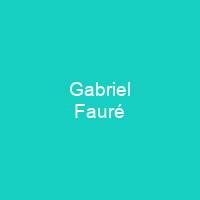Gabriel Urbain Fauré (12 May 1845 – 4 November 1924) was a French composer, organist, pianist and teacher. He was one of the foremost French composers of his generation. Among his best-known works are his Pavane, Requiem, Sicilienne, nocturnes for piano and the songs “Après un rêve” and “Clair de lune”
About Gabriel Fauré in brief

Faure was the youngest of six children, and the only one of his six children to display musical talent. The family had at one time been substantial landowners, but by the 19th century its means had become reduced. The composer’s paternal grandfather, Gabriel, was a butcher whose son became a schoolmaster. His mother was the daughter of a minor member of the nobility, and his sister had a traditional life as the wife of a public servant. In 1829 his father was appointed director of the École Normale d’Instituteurs, a teacher training college, at Montgauzy, near Foix, in France. When he was four years old, he was sent to live with a foster mother until he was 4 years old. His father told his son of his gift for music: “If that is what it means to have a vocation, then it is a very pleasant thing to have” In 1849 he returned to the school, which was attached to a chapel where he grew up, in an area of great beauty. There was a rather quiet year, but the only thing I remember really clearly is in that little chapel is the harmonium. Every time I could get away, I ran away and regaled myself. I remember that I was happy, quite without technique, but I do all,quite without technique.
You want to know more about Gabriel Fauré?
This page is based on the article Gabriel Fauré published in Wikipedia (as of Dec. 05, 2020) and was automatically summarized using artificial intelligence.







